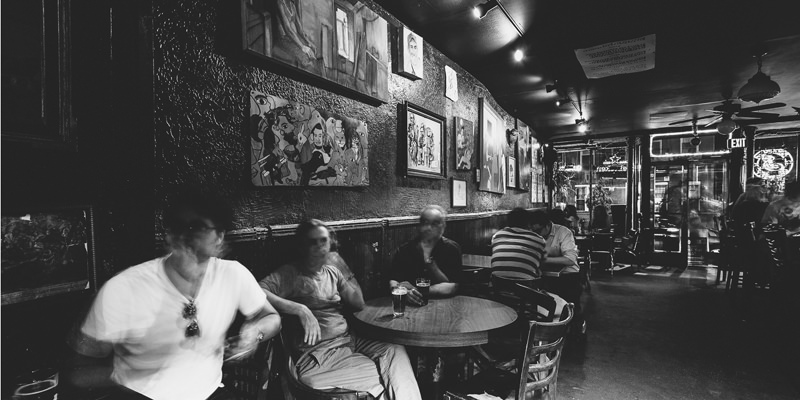A talented Playboy staff writer once defined a dive bar as a “church for down-and-outers and those who romanticize them, a rare place where high and low rub elbows—bums and poets, thieves and slumming celebrities. It’s a place that wears its history proudly.”
A truer description of the Lower East Side watering hole Sophie’s could not have been written. On East 5th Street in Alphabet City, Sophie’s is like a shout out to a time now past, back when the Lower East Side was the denizen of punks and artists, before gentrification set in with its high end shops, expensive hairstylists, and upscale wine shops. Though Jeff Bridges and Anthony Bourdain have both been sighted at Sophie’s, you still have to pass a group of junkies spacing out on cardboard planks to get to the joint, which bears no sign.
Multiple chalkboards sassily declare their resistance to the high-brow drinking culture that is slowly taking over the neighborhood.
Once inside, the bar certainly feels like a dive—that or the crown jewel of some lonesome Appalachian town. The interior is dark, lit in large part from the neon lights out front and the amber light reflecting off the mirror behind the bar. Rickety diner tables fill the room, surrounded by wooden chairs. The bar is short, seating maybe ten or twelve stools, and on the wall above it, multiple chalkboards sassily declare their resistance to the high-brow drinking culture that is slowly taking over the neighborhood: Six Point, Sweet Action, Dark N’ Stormy, and the single concession—Dogfish IPA.
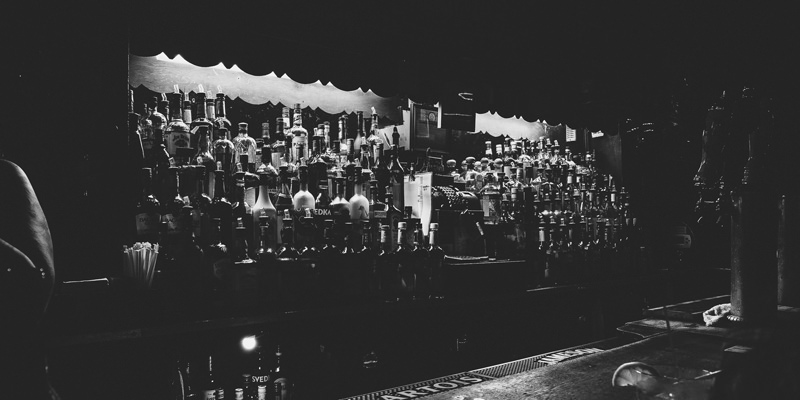 On a recent Tuesday night, men in moustaches with long gold chains around their necks shot pool with men in ironic work shirts and baseball caps. Older couples and artist types drank beer and talked about the day’s news. To the tunes coming from the jukebox, young men in mustaches made out with girls in bobs and denim mini dresses, the line between the ironic and the authentic a blur in the darkened bar. Even though people of all ages had come out to drink, there was a subtle yet pervasive feel of transgression, as though the fancy grown ups were out of town and had left the bar in uncertain hands.
On a recent Tuesday night, men in moustaches with long gold chains around their necks shot pool with men in ironic work shirts and baseball caps. Older couples and artist types drank beer and talked about the day’s news. To the tunes coming from the jukebox, young men in mustaches made out with girls in bobs and denim mini dresses, the line between the ironic and the authentic a blur in the darkened bar. Even though people of all ages had come out to drink, there was a subtle yet pervasive feel of transgression, as though the fancy grown ups were out of town and had left the bar in uncertain hands.
Sophie’s is a community bar, despite all the changes gentrification has wrought in the neighborhood. Patrons come for the mix of youngsters and old timers, skaters from Tompkins Square Park drinking and shooting pool with musicians who have lived in the neighborhood for half a century. “And there’s a good ratio of girls to men,” one of the two women in the bar that Tuesday night told me, nodding seriously.
The bartender, a young man with a light colored moustache and dark colored tattoos, doubted I would catch sight of the owner, and suggested I get the bar’s story from the bartender who came on shift at nine, a woman named Ama with an open smile, voluminous black and grey curls, and a tattoo of a carrot on her shoulder. But around the same time Ama came on shift, a man wearing a denim shirt and a propriety air appeared behind the bar. With salt-and-pepper scruff and clear blue eyes, he had the handsomeness of a washed up actor, and the gravelly voice to go with it.
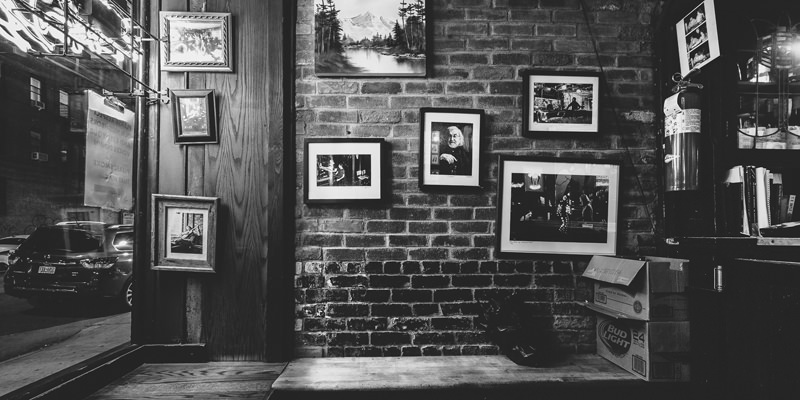 After making sure that I hadn’t come from the fire department to give him a hard time, he admitted to being the owner, but he didn’t want to answer questions. “Ama, come answer her questions!” He called down the bar. “Now she wants to know my name. Ama, tell her my name—if I tell her my name is Sam McShane, will you agree?”
After making sure that I hadn’t come from the fire department to give him a hard time, he admitted to being the owner, but he didn’t want to answer questions. “Ama, come answer her questions!” He called down the bar. “Now she wants to know my name. Ama, tell her my name—if I tell her my name is Sam McShane, will you agree?”
His name is Kirk, and in addition to Sophie’s, he owns two other bars in the neighborhood, Josie’s and Mona’s. “And we sell the same crappy beer in all three bars,” he said. “Hey, Ama! Do we serve anything fancy?” They sell one fancy drink, Ama says: Hudson Baby Bourbon, for $20 a shot. Kirk’s own drink of choice is Bud.
According to Kirk, all three bars are 100 years old. He pulls a photo off the wall from around Prohibition time, 1914. “I didn’t own it then,” he says. “But it sure feels like I did.”
This bar has been like this for 100 years. All I did was come in and not screw it up.
Sometime between when the photo was taken and when Kirk bought the place, Sophie’s belonged to a tough broad named Sophie Polny, a Ukrainian who buried two husbands during her time in the liquor business, according to Bob Corton, the bar’s next owner. Corton bought the place from Sophie in 1986, and catered to the Ukrainian men who would show up at 10 AM and spend the day lingering over beers and vodka. “If I showed up to open at 10:01, there’d be 8 guys waiting out front to get in and they’d hand me a bag of shit for being late,”Corton told Jeremiah Moss on his blog Jeremiah’s Vanishing New York. “It was a community,” he said. “When one bar couldn’t pay the rent, they’d have rent parties.” There was a dark side to the old LES, too. Corton had to worry about squatters using his restrooms to steal not only toilet paper, but also faucets and other fixtures, Moss wrote.
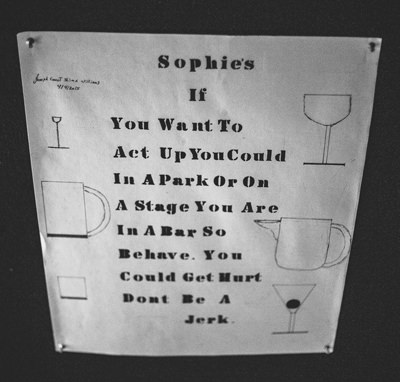
But health and finances and the changing Lower East Side meant that Corton almost had to close Sophie’s in 2008. That’s when Kirk stepped in, and soon after, Ama, who has worked at Sophie’s for seven years. “She got the job when I was out of town, though,” Kirk joked, and got a patient smile from Ama for his troubles.
Kirk has lived in the Lower East Side for 30 years, and has been drinking at Sophie’s for about that long. “I wiped down tables here for a while,” he said. “Then I disappeared for about fifteen years. I was traveling up the Amazon.” He wouldn’t say more about what he did or what brought him back. To answer the question what made him buy Sophie’s, he consulted Ama again.
“Ama, what made me buy it?” He growled down the bar.
“His best friend strong-armed him into it,” Ama obliged with a smile. “My best friend strong armed me into it,” Kirk repeated. “Oh right, and I had a kid on the way and my previous career wasn’t making me any money.” And, “I thought I’d meet interesting people I guess.” Kirk is now 47 (“Oh my God, the questions! The questions! Now she wants to know how old I am. Ama, how old am I? Older than a 45 year old breadbox.”). When he’s not in the bar, he’s with his family, raising his two children.
He believes a bar is a place people can go to feel comfortable, to socialize and talk and have experiences that they couldn’t have during the rest of their day. It’s about having a neighborhood vibe. “This bar has been like this for 100 years,” he said. “All I did was come in and not screw it up.”
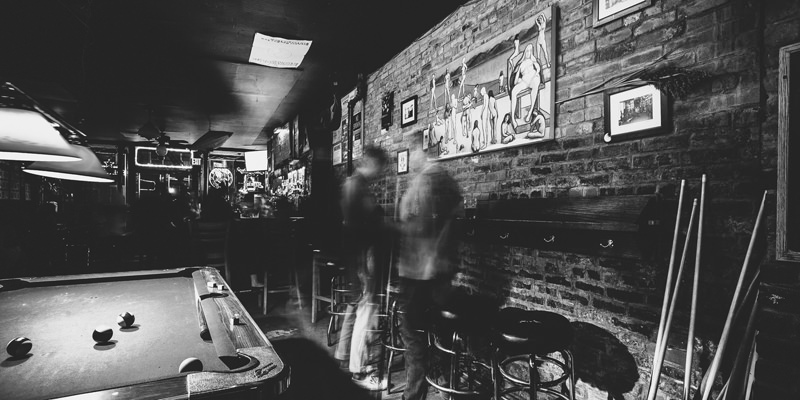
But there’s a deep tension involved in running a dive in a gentrifying neighborhood. It’s not simply a matter of maintaining an authentic, community feel in the midst of all the change. On the one hand, Kirk remains completely uninterested in the trends that have taken over the New York bar scene—the handlebar mustaches, the suspenders, the crushing and foaming mixologists. On the other hand, the Lower East Side used to be a tough neighborhood. There was an unpleasant element that gentrification has now marginalized, Kirk says, an element that used to migrate to the few bars that weren’t succumbing to the new trends. “It became a very delicate balance when I took over these bars, to try to keep them the same, yet clean them up a little bit at the same time because they were not particularly pleasant places.” The only thing Kirk says he did to improve Sophie’s was “kicking out the drug dealers.”
Where can a guy get a drink when the last gin mill closes down, when there’s nothing left but the fern bar or the lounge, when the barkeep has been replaced by a mixologist?
“There was a lot of screaming and yelling, I got a lot of finger pointing that I’d ruined the bar, how could I do this to a tried and true neighborhood institution,” he recalled. “And I worried about it a little bit because the fact is, I liked some of those people. I just didn’t want them in my place of business.” Still, running a successful business in the new Lower East Side means cleaning up your act. “You gotta keep up with it, you gotta make some concessions, you can’t have the dregs sitting here dealing drugs,” he says. “That doesn’t mean you gotta completely sanitize it. It means, you gotta run a business. You gotta mop the floor, you gotta clean the bathrooms.”
Anthony Bourdain put it succinctly when he visited Sophie’s in 2009. “I don’t want no wide screens, high-fiving white guys, no fauxhawks or gel heads or hot chicks with douchebags,” he said. “I don’t want anything on the jukebox that will distract an old gentleman such as myself from drinking the heart right out of the afternoon if I should choose to do so … Where can a guy get a drink when the last gin mill closes down, when there’s nothing left but the fern bar or the lounge, when the barkeep has been replaced by a mixologist?”
Why, you can go to Sophie’s.
All images by Anthony Disparte

